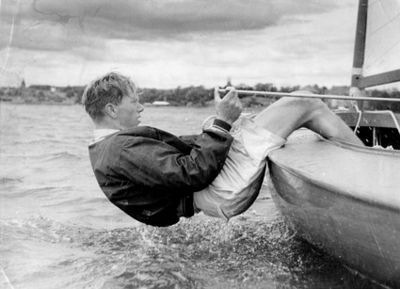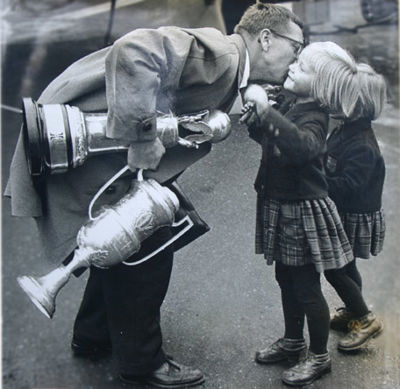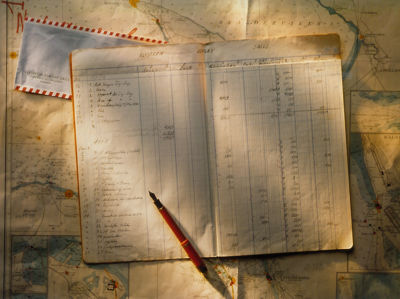

L'année 2024 est une année importante dans l'histoire d'Elvstrøm Sails, car nous célébrons notre 70e anniversaire – une belle occasion de revenir sur l’histoire d’Elvstrøm Sails et bien sûr sur celle de notre fondateur, Paul Elvstrøm.
Pour Paul Elvstrøm, grandir en bord de mer près de Copenhague a marqué le début d'une passion à vie pour la voile – une passion qui allait enflammer une carrière légendaire. Il a construit son incroyable parcours dans la voile bien avant de transformer ses idées en produits et de fonder ce qui allait devenir Elvstrøm Sails aujourd’hui. Paul Elvstrøm possédait un mélange unique d’ingéniosité et de flair pour ce sport, tout en étant un grand ambassadeur de l'esprit sportif, qu’il considérait comme une valeur fondamentale de la voile.
Paul est né le 25 février 1928 à Hellerup, juste au nord de Copenhague. L'emplacement de la maison familiale a joué un rôle déterminant dans tout ce qui a suivi. Située près du littoral, la proximité avec l’Øresund a attiré Paul Elvstrøm vers la voile. Il a rejoint le club nautique local, le Hellerup Sejlklub, à l'âge de 10 ans, et c’est aussi là que fut installé le tout premier siège d’Elvstrøm Dinghy Sails.

Innover dans et en dehors du sport
Durant son adolescence, Paul Elvstrøm suivait un entraînement rigoureux et participait à autant de compétitions que possible. C’est aussi à cette période que son esprit innovant a commencé à se révéler. Lorsqu'il s'est qualifié pour ses premiers Jeux olympiques, il s’est retrouvé face à un désavantage lié à son poids.
Dans les années 1930, 1940 et 1950, les compétiteurs plus lourds semblaient bénéficier d’un avantage dans les courses de dériveurs. Avec un poids inférieur de 20 à 30 kilos par rapport à ses adversaires, Paul Elvstrøm n’avait pas le gabarit idéal pour la compétition.
C’est à ce moment-là qu’il s’est entraîné et a perfectionné la technique qui allait bientôt devenir un standard : la technique du rappel. En se penchant hors du bateau plutôt qu’en restant assis à l’intérieur, il a retrouvé l’avantage qu’il n’avait pas au départ.
Il a vraiment commencé à perfectionner cette technique après avoir remporté sa première médaille d'or olympique en 1948. Rapidement, cette technique s’est avérée essentielle pour exploiter pleinement le potentiel du Finn, un dériveur particulièrement exigeant où le poids et son positionnement étaient cruciaux.
La maîtrise de cette technique a bientôt fait du gabarit de Paul Elvstrøm le modèle idéal pour un régatier. Après sa victoire olympique à seulement 18 ans à Londres en 1948, l’introduction du Finn aux Jeux olympiques d’Helsinki en 1952 lui a permis de pleinement exprimer son talent. Il s'est rapidement imposé dans cette nouvelle catégorie de dériveurs et a dominé la classe Finn pendant les huit années suivantes. Ce fut une période jalonnée de trois titres olympiques consécutifs, ainsi que de deux titres de champion du monde et un titre de champion d’Europe.

Une nouvelle aventure entrepreneuriale
Au sommet de la carrière olympique de Paul Elvstrøm, une nouvelle aventure entrepreneuriale commença à prendre forme. En 1953, Paul Elvstrøm et son ami proche Erik ‘Strit’ Johansen se mirent à concevoir leurs propres voiles pour la course en dériveur. Ensemble, ils identifièrent plusieurs aspects à améliorer en matière de design et de production. La première étape consistait à optimiser une machine à coudre pour ce travail spécifique, puis à créer un outil permettant de tracer des lignes parallèles sur la toile à voile.
Cet outil leur permettait d’obtenir des lignes parfaitement droites et d’assurer que les plis et les coutures soient toujours d’une précision absolue. Ils trouvèrent ainsi une excellente solution et, même si leur choix de tissu relevait davantage de la chance que d’une véritable connaissance initiale, ils réalisèrent rapidement qu’ils avaient trouvé une formule gagnante. (Paul Elvstrøm Fortæller, Creagh-Osborne / Carlsen, 1987; 34)

Pour leurs premières productions, le duo se concentra sur le dériveur Pirate, une embarcation d’origine allemande, qui s’avéra rapidement être un succès. Erik ‘Strit’ Johansen étant un passionné de voile dans la classe Snipe, il était naturel que la prochaine étape soit la production de voiles pour cette catégorie. Là encore, les voiles d’Elvstrøm Dinghy Sails rencontrèrent un franc succès.
Le succès initial ouvrit rapidement de nouvelles perspectives, et à mesure que l’année 1953 laissait place à 1954, Paul Elvstrøm aménagea une petite usine dans le sous-sol de la villa familiale à Hellerup. La production connut une croissance rapide, donnant naissance à Elvstrøm Sails tel que nous le connaissons aujourd’hui – une histoire que nous avons déjà évoquée ici. (Paul Elvstrøm Fortæller, Creagh-Osborne / Carlsen, 1987; 35-37)
Alors que son entreprise prospérait, Paul Elvstrøm était plus occupé que jamais. Avant cette nouvelle aventure, il menait une carrière florissante en tant qu’entrepreneur en bâtiment, mais il troqua rapidement la maçonnerie pour la fabrication de voiles. Dans le domaine sportif, sa carrière atteignait de nouveaux sommets chaque année. Après l’or olympique de 1952, il remporta un autre titre olympique dans la classe Finn en 1956, puis en 1960. Il ajouta également deux titres mondiaux en 505 en 1957 et 1958, ainsi que deux titres mondiaux en Finn en 1959 et 1960, enrichissant encore un palmarès déjà impressionnant.

Battre des records
Ce fut le début et la poursuite d'une carrière véritablement remarquable dans la voile. Avec quatre médailles d’or remportées lors de quatre Jeux olympiques consécutifs, Paul Elvstrøm a marqué l’histoire et battu des records à une époque unique. Depuis, un seul marin a surpassé son record olympique : Ben Ainslie, qui a remporté quatre médailles d’or avant d’en ajouter une cinquième. Mais ce qui rend encore plus impressionnant le palmarès de Paul Elvstrøm, c’est son incroyable série de titres mondiaux.
À ce jour, Paul Elvstrøm reste le seul marin à avoir remporté des titres mondiaux dans un total de sept classes différentes : 505, Snipe, Finn, Flying Dutchman, Star, Soling et Half Ton. Au total, il a décroché 13 titres de champion du monde.
Concilier la gestion d’une entreprise en pleine expansion avec une carrière de régatier de haut niveau mettait toutefois une énorme pression sur les épaules de Paul Elvstrøm. Il en ressentit les effets en plein cœur des Jeux olympiques de 1960 à Naples. La veille de la finale, il tomba malade mais trouva la force de continuer. Il remporta la course décisive et décrocha l’or, mais renonça à prendre le départ de la dernière course en raison de son état de santé. (Paul Elvstrøm Fortæller, Creagh-Osborne / Carlsen, 1987; 58-60)
Après ces Jeux olympiques, Elvstrøm décida de faire une pause dans la voile de compétition. Hormis une participation au championnat du monde de Flying Dutchman en 1962, qu’il remporta aux côtés de Hans Fogh, il se tint éloigné des régates pendant plusieurs années.

Une pause – et un retour en force
La Fédération danoise de voile inscrivit Paul Elvstrøm comme remplaçant pour les Jeux olympiques de 1964 au Japon. Il ne savait pas exactement dans quelle catégorie il était censé être remplaçant, mais ce retour aux Jeux raviva en lui la passion de la compétition.
Dès lors, Paul Elvstrøm se prépara à un retour au plus haut niveau. Bien qu’il ne remporta plus de médailles olympiques – terminant 4ᵉ en Starboat en 1968 et en Tornado en 1984 –, il connut de nombreux succès sur la scène mondiale et européenne.
Il s’adapta brillamment au Starboat et trouva ensuite beaucoup de succès avec l’introduction du Soling. En 1966 et 1967, il remporta deux fois de suite le championnat du monde en Star, puis enchaîna avec deux titres mondiaux en Soling en 1969 et 1974, ainsi que deux titres européens en 1970 et 1971.
Du côté de son entreprise, l’économie mondiale traversa une période difficile au début des années 1970, ce qui impacta également l’industrie de la fabrication de voiles. Malgré tout, Elvstrøm réussit à maintenir son entreprise à flot jusqu’à ce qu’il vende la majorité de ses parts en 1976.

Le duo père-fille
Cette vente permit à Paul Elvstrøm de profiter des compétitions d’une manière différente. Il effectua un grand changement en passant des quillards aux catamarans Tornado, ce qui marqua le début d’un duo père-fille prometteur avec sa fille Trine.
Au départ, ils naviguaient pour le plaisir, mais ils réalisèrent rapidement qu’ils formaient une excellente équipe sur ce type de bateau.
Ils achetèrent un Tornado neuf auprès du chantier naval allemand Glass et remportèrent le championnat d’Europe en 1983. L’année suivante, ils réitérèrent l’exploit et se qualifièrent pour les Jeux olympiques de Los Angeles en 1984. (Paul Elvstrøm Fortæller, Creagh-Osborne / Carlsen, 1987; 166)

Ils réalisèrent une belle performance, mais manquèrent de peu la médaille de bronze – Trine ayant en plus souffert de problèmes de santé en pleine compétition. Ils terminèrent finalement à la 4ᵉ place. Paul et Trine continuèrent à régater en Tornado et participèrent également aux Jeux olympiques de 1988, marquant ainsi la dernière participation olympique de Paul, 40 ans après son triomphe initial en 1948.
Tout au long de sa carrière illustre, Paul Elvstrøm accumula un impressionnant palmarès comprenant quatre médailles d’or olympiques et 13 titres de champion du monde dans plusieurs disciplines de la voile. Son impact sur ce sport est inestimable, et son héritage continue d’influencer la voile de compétition aujourd’hui.
Paul Elvstrøm s’est éteint le 7 décembre 2016, mais son esprit demeure dans le cœur et l’esprit des marins du monde entier. Il restera à jamais une icône de la voile, un pionnier et un véritable champion.